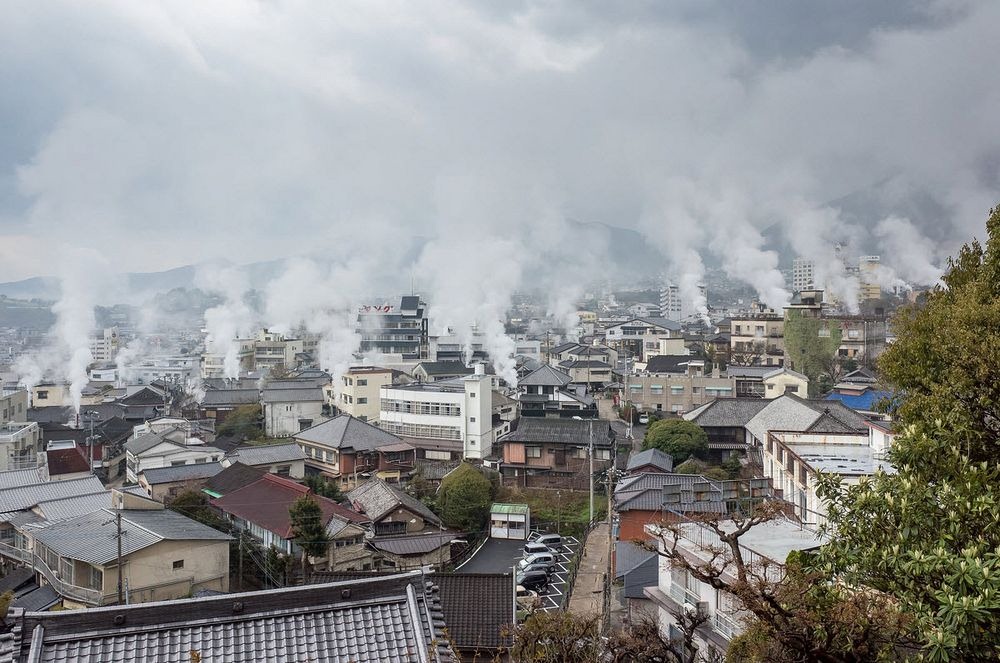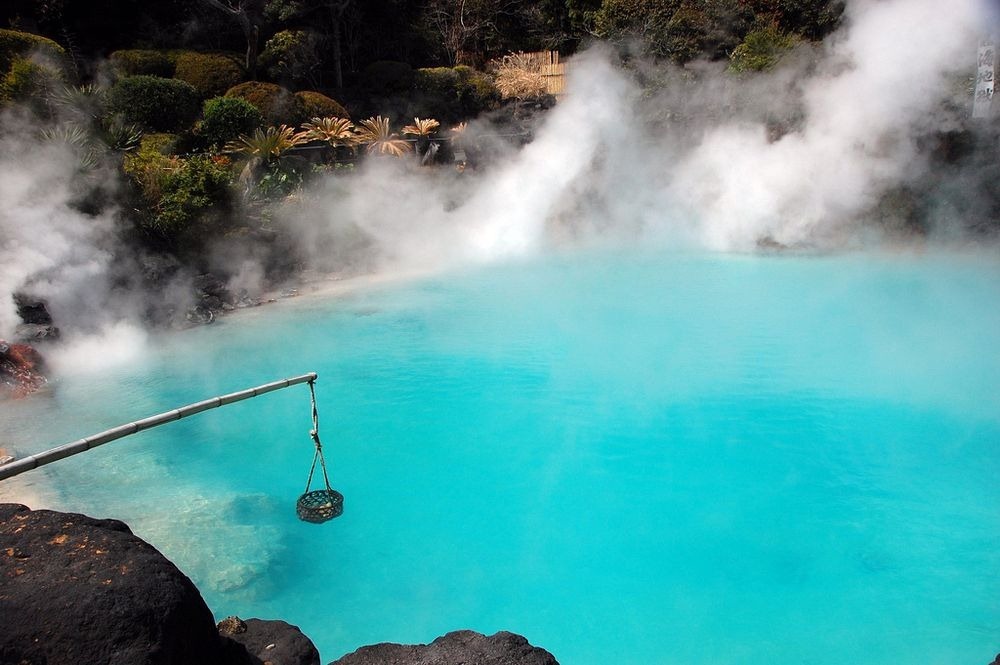The Japanese island of Kyushu is a hotbed of geothermal activity, thanks to the country’s most active volcano Mt Aso, that the island is home to. The most famous of these natural hot springs are located near Beppu, a small city tucked between a bay of the Inland Sea and two dormant volcanoes on the east shore of the island. Beppu has more than 2,900 hot spring vents that discharges more than 130,000 tons of hot water from the ground every day, second only to that of the Yellowstone National Park in the United States. Vapors rising up from these vents make it seem as if the entire city is on fire.
Of particular interest are the “Jigokus” or “Hells” —the city’s famed steaming hot springs. Beppu has eight famous jigokus, and they are indeed, hell on earth. These hot springs have temperatures that ranges from 50 to 99.5 °Celsius. Needless to say, the jigokus are not suitable for bathing, but they the most popular attraction in the city.
Steam escaping out of thousands of vents in Beppu. Photo credit: seiko tomono/Flickr

Photo credit: Thomas/Flickr
Aside from tourism, the numerous hot springs of Beppu play an important part in the daily lives of the city's residents. Steam from wells is used to heat water which is delivered by pipes to homes and businesses. Some of it goes into homes and restaurants for cooking. The water is also used for agricultural research, physical therapy and recreational bathing. Of course, Beppu is the largest hot spring resort in the world.
Chinoike Jigoku
The most spectacular of Beppu’s hot springs is the vermillion-colored Chinoike Jigoku or “blood pond hell”. The color comes from the presence of iron oxide and magnesium oxide.
Photo credit: Elvin/Flickr
Photo credit: sonotoki/Flickr
Umi Jigoku
Umi Jigoku or “sea hell” is so called because it features bright cobalt blue water that looks as cool as the sea. But don’t be fooled, the water here is scalding hot at 98 degrees. In its spacious gardens, there are a few secondary, orange colored hot springs and a large, clear water pond with lotus flowers whose large leaves are strong enough to carry small children. Stores near Umi Jigoku sells pudding and boiled eggs cooked in the hot spring.
Photo credit: Elvin/Flickr

Cooking eggs in the hot spring. Photo credit: Gabriel Rodríguez/Flickr
Photo credit: sonotoki/Flickr
Oniishibozu Jigoku
The “Shaven Monk's Head Hell” is named after the mud bubbles which is said to look like the shaven heads of monks. Adjacent to the hell is a public bath with multiple pools.
Photo credit: japan.apike.ca
Photo credit: sonotoki/Flickr
Shiraike Jigoku
The “White Pond Hell” features a pond of hot, milky water. The color results from a mixture of boric acid, salt, sodium silicate and calcium bicarbonate. The pond is surrounded by a nice garden and a small, run-down aquarium where piranhas are kept.
Photo credit: sonotoki/Flickr
Kamado Jigoku
The "Cooking Pot Hell" features several boiling ponds with a red demon statue guarding the entrance. On the grounds, visitors can drink the hot spring water, enjoy hand and foot baths, and try various snacks cooked or steamed by the hot spring.
Photo credit: sonotoki/Flickr
Photo credit: TANAKA Juuyoh/Flickr
Oniyama Jigoku
The “Demon Mountain Hell”, also known as "Crocodile Hell" is home to a large number of crocodiles that are bred and kept on the grounds.
Photo credit: Colleen/Flickr
Photo credit: François Rejeté/Flickr
Yama Jigoku
The "Mountain Hell" features small ponds of steaming hot water. There is a mini zoo nearby with large animals in small cages.
Photo credit: sonotoki/Flickr
Tatsumaki Jigoku
The “Geyser Hell” is a hot geyser which erupts every 30-40 minutes for about 6-10 minutes. Its spout can reach 50 meters, but a stone plate above the geyser prevent it to reaching its full height, probably to prevent it from spraying hot water all over the place and onto tourists.
Photo credit: RachelH/Flickr
Sources: Japan Guide / CNN / www.beppu-jigoku.com


























It's great!
ReplyDelete